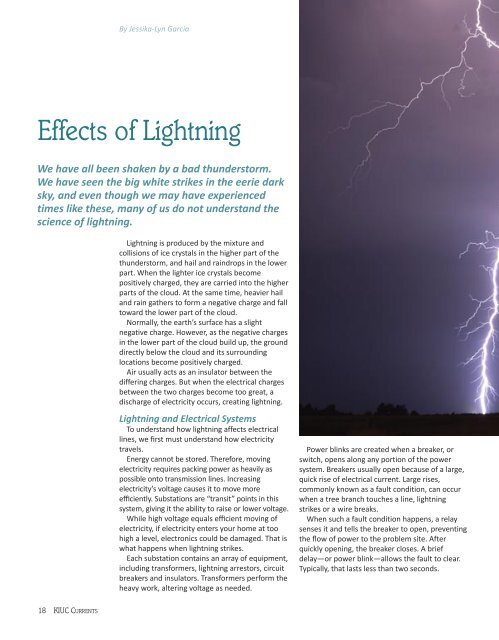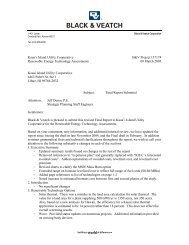August 2011 - Kauai Island Utility Cooperative
August 2011 - Kauai Island Utility Cooperative
August 2011 - Kauai Island Utility Cooperative
You also want an ePaper? Increase the reach of your titles
YUMPU automatically turns print PDFs into web optimized ePapers that Google loves.
Effects of Lightning<br />
18 KIUC CURRENTS<br />
By JessikaLyn Garcia<br />
We have all been shaken by a bad thunderstorm.<br />
We have seen the big white strikes in the eerie dark<br />
sky, and even though we may have experienced<br />
times like these, many of us do not understand the<br />
science of lightning.<br />
Lightning is produced by the mixture and<br />
collisions of ice crystals in the higher part of the<br />
thunderstorm, and hail and raindrops in the lower<br />
part. When the lighter ice crystals become<br />
positively charged, they are carried into the higher<br />
parts of the cloud. At the same time, heavier hail<br />
and rain gathers to form a negative charge and fall<br />
toward the lower part of the cloud.<br />
Normally, the earth’s surface has a slight<br />
negative charge. However, as the negative charges<br />
in the lower part of the cloud build up, the ground<br />
directly below the cloud and its surrounding<br />
locations become positively charged.<br />
Air usually acts as an insulator between the<br />
differing charges. But when the electrical charges<br />
between the two charges become too great, a<br />
discharge of electricity occurs, creating lightning.<br />
Lightning and Electrical Systems<br />
To understand how lightning affects electrical<br />
lines, we first must understand how electricity<br />
travels.<br />
Energy cannot be stored. Therefore, moving<br />
electricity requires packing power as heavily as<br />
possible onto transmission lines. Increasing<br />
electricity’s voltage causes it to move more<br />
efficiently. Substations are “transit” points in this<br />
system, giving it the ability to raise or lower voltage.<br />
While high voltage equals efficient moving of<br />
electricity, if electricity enters your home at too<br />
high a level, electronics could be damaged. That is<br />
what happens when lightning strikes.<br />
Each substation contains an array of equipment,<br />
including transformers, lightning arrestors, circuit<br />
breakers and insulators. Transformers perform the<br />
heavy work, altering voltage as needed.<br />
Power blinks are created when a breaker, or<br />
switch, opens along any portion of the power<br />
system. Breakers usually open because of a large,<br />
quick rise of electrical current. Large rises,<br />
commonly known as a fault condition, can occur<br />
when a tree branch touches a line, lightning<br />
strikes or a wire breaks.<br />
When such a fault condition happens, a relay<br />
senses it and tells the breaker to open, preventing<br />
the flow of power to the problem site. After<br />
quickly opening, the breaker closes. A brief<br />
delay—or power blink—allows the fault to clear.<br />
Typically, that lasts less than two seconds.

















